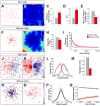Contact repulsion controls the dispersion and final distribution of Cajal-Retzius cells
- PMID: 23395373
- PMCID: PMC3569744
- DOI: 10.1016/j.neuron.2012.11.023
Contact repulsion controls the dispersion and final distribution of Cajal-Retzius cells
Abstract
Cajal-Retzius (CR) cells play a fundamental role in the development of the mammalian cerebral cortex. They control the formation of cortical layers by regulating the migration of pyramidal cells through the release of Reelin. The function of CR cells critically depends on their regular distribution throughout the surface of the cortex, but little is known about the events controlling this phenomenon. Using time-lapse video microscopy in vivo and in vitro, we found that movement of CR cells is regulated by repulsive interactions, which leads to their random dispersion throughout the cortical surface. Mathematical modeling reveals that contact repulsion is both necessary and sufficient for this process, which demonstrates that complex neuronal assemblies may emerge during development through stochastic events. At the molecular level, we found that contact repulsion is mediated by Eph/ephrin interactions. Our observations reveal a mechanism that controls the even distribution of neurons in the developing brain.
Copyright © 2013 Elsevier Inc. All rights reserved.
Figures








References
-
- Abercrombie M. Contact inhibition and malignancy. Nature. 1979;281:259–262. - PubMed
-
- Abercrombie M, Heaysman J. Observations on the social behaviour of cells in tissue culture. I Speed of movement of chick heart fibroblasts in relation to their mutual contacts. Exp Cell Res. 1953;5:111–131. - PubMed
-
- Alcantara S, Pozas E, Ibanez CF, Soriano E. BDNF-modulated spatial organization of Cajal-Retzius and GABAergic neurons in the marginal zone plays a role in the development of cortical organization. Cereb Cortex. 2006;16:487–499. - PubMed
-
- Anderson SA, Eisenstat DD, Shi L, Rubenstein JLR. Interneuron migration from basal forebrain to neocortex: dependence on Dlx genes. Science. 1997;278:474–476. - PubMed
Publication types
MeSH terms
Substances
Grants and funding
LinkOut - more resources
Full Text Sources
Other Literature Sources
Miscellaneous

